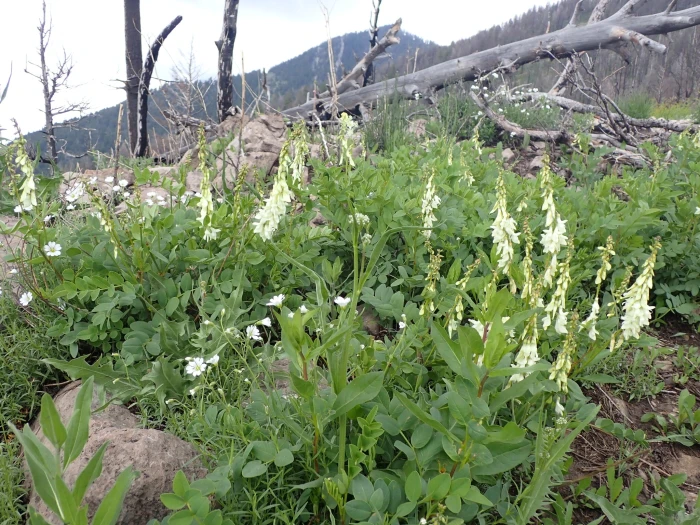Yellow Sweetvetch
(Hedysarum sulphurescens)
Yellow Sweetvetch (Hedysarum sulphurescens)
/
/

Matt Lavin
CC BY 4.0
Image By:
Matt Lavin
Recorded By:
Copyright:
CC BY 4.0
Copyright Notice:
Photo by: Matt Lavin | License Type: CC BY 4.0 | License URL: http://creativecommons.org/licenses/by/4.0/ | Rights Holder: Matt Lavin | Publisher: iNaturalist | Date Created: 2023-06-12T11:21:07-07:00 |






















Estimated Native Range
Climate Requirements for The Woodlands, Texas
| This Plant | Your Site | Plant Suitability for Your Location | ||
|---|---|---|---|---|
| • Precipitation | 9" - 61" | 46" | Aquatic | Aquatic |
| • High Temp. | 52°F - 86°F | 94°F | Your summers may be too hot for this plant. | Too hot |
| • Low Temp. | -5°F - 19°F | 40°F | OK, but your winter temperatures are warmer than normal for this plant | OK |
This plant may not grow well at your location - your precipitation is too high.
Summary
Hedysarum sulphurescens, commonly known as yellow sweetvetch, is a perennial herb native to alpine and subalpine zones, meadows, and open forests. It is often found in the mountainous regions of North America, including the Rocky Mountains and other ranges. This species typically grows to a height of 0.5 to 2 feet (15 to 60 cm) and spreads 0.5 to 1.5 feet (15 to 45 cm). Yellow sweetvetch has compound leaves with multiple leaflets and produces clusters of small, pea-like yellow flowers in the summer, which are moderately showy and attract pollinators.
Yellow sweetvetch is valued for its nitrogen-fixing ability, which can improve soil fertility, making it a beneficial addition to restoration projects and naturalistic plantings. It is also used in wildflower gardens for its attractive foliage and flowers. In cultivation, it prefers full sun to partial shade and requires well-drained soils. While it is drought-tolerant once established, it benefits from moderate watering. There are no major diseases or pests associated with this plant, but it may require protection from grazing if planted in areas with wildlife.CC BY-SA 4.0
Yellow sweetvetch is valued for its nitrogen-fixing ability, which can improve soil fertility, making it a beneficial addition to restoration projects and naturalistic plantings. It is also used in wildflower gardens for its attractive foliage and flowers. In cultivation, it prefers full sun to partial shade and requires well-drained soils. While it is drought-tolerant once established, it benefits from moderate watering. There are no major diseases or pests associated with this plant, but it may require protection from grazing if planted in areas with wildlife.CC BY-SA 4.0
Plant Description
- Plant Type: Herb
- Height: 1.5-3 feet
- Width: 1.5-2 feet
- Growth Rate: Moderate
- Flower Color: White, Yellow
- Flowering Season: Spring, Summer
- Leaf Retention: Deciduous
Growth Requirements
- Sun: Full Sun, Part Shade
- Water: Low
- Drainage: Medium
Common Uses
Bee Garden, Bird Garden, Border Plant, Low Maintenance
Natural Habitat
Native to alpine and subalpine zones, meadows, and open forests in mountainous regions
Other Names
Common Names: Yellow Sweetvetch, Sulphur Flower Sweetvetch, Yellow Hedysarum, Sulphur Hedysarum, Sulphur Sweet-Vetch, Rydberg’s Sweetvetch
Scientific Names: Hedysarum sulphurescens, Hedysarum albiflorum, Hedysarum boreale var. albiflorum, Hedysarum boreale var. flavescens, Hedysarum flavescens, Hedysarum sulfureum
GBIF Accepted Name: Hedysarum sulphurescens